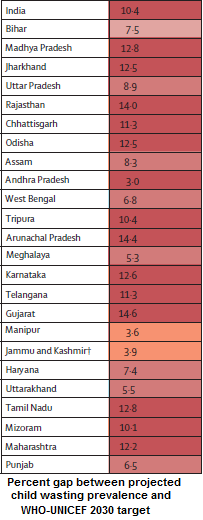A Bill & Melinda Gates Foundation-funded study has found that malnutrition remains the “predominant risk factor for death in children younger than 5 years of age”, accounting for 68.2% of the total under-5 deaths, and remains the “leading risk factor for health loss for all ages” despite the Government of India’s huge budgetary funding to the tune of US$1.3 billion and the “hope” that the Swacch Bharat Mission would reduce malnutrition.

Modi receiving Gates Foundation award
The study, which has also been supported by the Indian Council of Medical Research, states that the prevalence of low birthweight in India in 2017 was 21.4%, child stunting 39.3%, child wasting 15.7%, child underweight 32.7%, anaemia in children 59.7%, anaemia in women 15–49 years of age 54.4%, exclusive breastfeeding 53.3%, and child overweight 11.5% (8.5–14.9).
Based on these estimates, the study believes, it is safe to assume that the National Nutrition Mission (NNM) 2022 – a flagship programme of the Ministry of Women and Child Development (MWCD), Government of India, with goals to achieve improvement in nutritional status of Children from 0-6 years, adolescent girls, pregnant women and lactating mothers in a time bound manner – would not be achieved.
Thus, according to the study, the trend between 2010 and 2017 suggests in 2022 “there would be 8.9% excess prevalence for low birthweight, 9.6% for stunting, 4.8% for underweight, 11.7% for anaemia in children, and 13.8% for anaemia in women relative to the 2022 targets.”
It continues, “For the additional indicators in the WHO and UNICEF 2030 targets, the trends up to 2017 would lead to 10.4% excess prevalence for wasting, 14.5% excess prevalence for overweight, and 10.7% less exclusive breastfeeding in 2030.”
The study believes, “The trends up to 2017 indicate that substantially higher rates of improvement will be needed for all malnutrition indicators in most states to achieve the Indian 2022 and the global 2030 targets.”
Titled “The burden of child and maternal malnutrition and trends in its indicators in the states of India: the Global Burden of Disease Study 1990–2017”, the study states, “Within child growth failure, the highest contribution to disability-adjusted life years (DALYs) was from wasting, the prevalence of which declined only moderately in India during 2010–17.”
While agreeing that the prevalence of stunting and underweight has been decreasing, the study says, “However, the prevalence has remained very high in India at 39% and 33%, respectively, in 2017.” Similarly, “the prevalence of anaemia has been extremely high in India at 60% in children and 54% in women in 2017, with only moderate decline during 2010–17.”
At the same time, according to the study, “The prevalence of child overweight has increased considerably in India in the past decade, with a prevalence of 12% in 2017.”
The findings in the study indicate that, if the trends up to 2017 continue, “The NNM 2022 and the WHO and UNICEF 2030 targets will not be achieved in most states of India, except for low birthweight and stunting in a few states and exclusive breastfeeding in several.”
It adds, “Because low birthweight was the largest contributor to child malnutrition DALYs in India, its slow decline should be addressed as a priority. South Asia, with India as its largest component, is estimated to have the highest prevalence of low birthweight for any region in the world.”
At the same time, the study regrets, “A major issue with tracking low birthweight is the poor quality of birthweight data in many low-income and middle-income countries, including India.”
It says, “The higher proportion of underweight women in the reproductive age group in India compared with sub-Saharan Africa has been suggested to contribute to a higher prevalence of low birthweight in India, even though sub-Saharan Africa is poorer.”
The study believes, “The prevalence of stunting, an indicator of chronic undernutrition, caused by a variety of social, environmental, and economic risk factors, is unsurprisingly highest in the less developed states. However, the prevalence of wasting, indicative of acute undernutrition, is highest in some of the more developed states.”
Thus, the study finds that gap between projected child wasting percent prevalence and WHO- UNICEF 2030 target is 14.6% in Gujarat, one of the “richest” states. This is against the national average of 10.4%. In fact, the study finds that in no other state the wasting gap for achieving the target is so high as that of Gujarat.
The study finds that gap between projected child wasting percent prevalence and WHO- UNICEF 2030 target is 14.6% in Gujarat, the highest in India
Wasting, or low weight for height, is a strong predictor of mortality among children under five. It is usually the result of acute significant food shortage and/or disease.
Referring to the Government of India’s revamped NNM with a budget of US$1.3 billion to “comprehensively address the challenge of persistent undernutrition” by systematically synergising a variety of nutrition-related activities of various government ministries and stakeholders in order to strengthen many maternal and child health initiatives, the study calls “the malnutrition indicator targets set by NNM for 2022 “aspirational”.
It says, while the ongoing sanitation improvement drive in India under the Swachh Bharat Mission is may contribute to the reduction in malnutrition, “The rate of improvement needed to achieve the targets is much higher than the rate observed.”
Courtesy: Counter View
